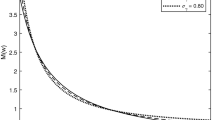Abstract
This paper generalizes European call options on the extremum of several risky assets in a Poisson-Gaussian model which allows both the risky assets and stochastic interest rates moving randomly with jump risks. The stochastic interest rate is assumed to follow an extended multi-factor HJM model with jumps. The authors provide explicitly the closed-form solutions of these options through the change of numeraire technique and examine the effects of both jump risks and stochastic interest rate on the option price with numerical experiment. The model can be seen as an extension of Stulz (1982), Johnson (1987) and Lindset (2006).
Similar content being viewed by others
References
R. M. Stulz, Option on the minimum or the maximum of two risky assets, Journal of Financial Economics, 1982, 10(2): 161–185.
H. Johnson, Options on the maximum or the minimum of several assets, Journal of Financial and Quantitative Analysis, 1987, 22(3): 277–283.
X. P. Wu and J. E. Zhang, Options on the minimum or the maximum of two average prices, Review of Derivatives Research, 1999, 3(3): 183–204.
Y. K. Kwok and H. Y. Wong, Currency-translated foreign equity options wit path dependent features and their multi-asset extensions, International Journal of Theoretical and Applied Finance, 2000, 3(2): 257–278.
S. Martzoukos, The option on n assets with exchange rate and exercise price risk, Journal of Multinational Financial Management, 2001, 11(1): 1–15.
S. Lindset, A generalization of the formulas for options on the Maximum or the Minimum of several assets, The European Journal of Finance, 2006, 12(8): 717–730.
R. C. Merton, Option pricing when underlying stock returns are discontinuous, Journal of Financial Economics, 1976, 3(2): 125–144.
R. A. Jarrow and E. Rosenfeld, Jump risks and the intertemporal capital asset pricing model, Journal of Business, 1984, 57(3): 337–351.
C. Ball and W. Torous, On jumps in common stock prices and their impact on call option pricing, Journal of Finance, 1985, 40(1): 155–173.
G. Bakshi, C. Cao, and Z. Chen, Empirical performance of alternative option pricing models, Journal of Finance, 1997, 52(5): 2003–2049.
S. Das, The surprise element: Jumps in interest rates, Journal of Econometrics, 2002, 106(1): 27–65.
I. Bardhan and X. L. Chao, Pricing options on securities with discontinuous returns, Stochastic Processes and Their Applications, 1994, 48(1): 123–137.
C. Mancini, The European options hedge perfectly in a Poisson-Gaussian stock market model, Applied Mathematical Finance, 2002, 9(2): 87–102.
H. Shirakawa, Interest rate option pricing with Poisson-Gaussian forward rate curve processes, Mathematical Finance, 1991, 1(1): 77–94.
C. Chiarella and C. N. Sklibosios, A class of Jump-diffusion bond pricing models within the HJM framework, Asia-Pacific Financial Markets, 2003, 10(2–3): 87–127.
D. Heath, R. Jarrow, and A. Morton, Bond pricing and the term structure of interest rates: A new methodology for contingent claims valuation, Econometrica, 1992, 25(1): 77–106.
T. Björk, Y. Kabanov, and W. Runggaldier, Bond market structure in the presence of marked point processes, Mathematical Finance, 1997, 7(2): 211–223.
H. Geman, E. N. Karoui, and J. C. Rochet, Change of numeraire, change of probability measures and pricing of options, Journal of Applied Probability, 1995, 32: 443–458.
Author information
Authors and Affiliations
Corresponding author
Additional information
This research was Supported by the National Natural Science Foundation of China under Grant No. 40675023, the “985” Project of Hunan University and the Guangxi Natural Science Foundation under Grant No. 0991091.
Rights and permissions
About this article
Cite this article
Deng, G., Huang, L. A Poisson-Gaussian model to price European options on the extremum of several risky assets within the HJM framework. J Syst Sci Complex 23, 769–783 (2010). https://doi.org/10.1007/s11424-010-7205-y
Received:
Revised:
Published:
Issue Date:
DOI: https://doi.org/10.1007/s11424-010-7205-y




